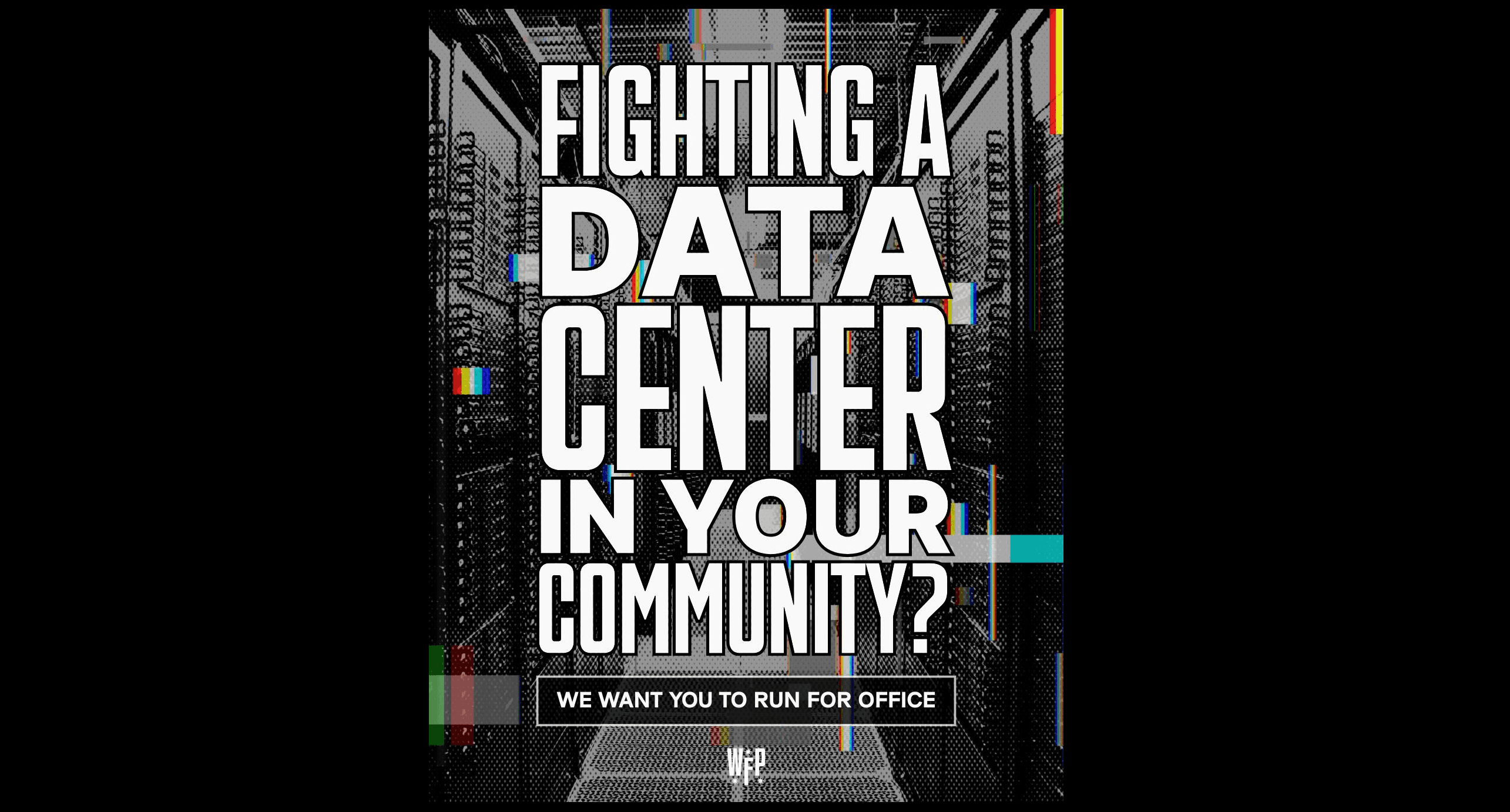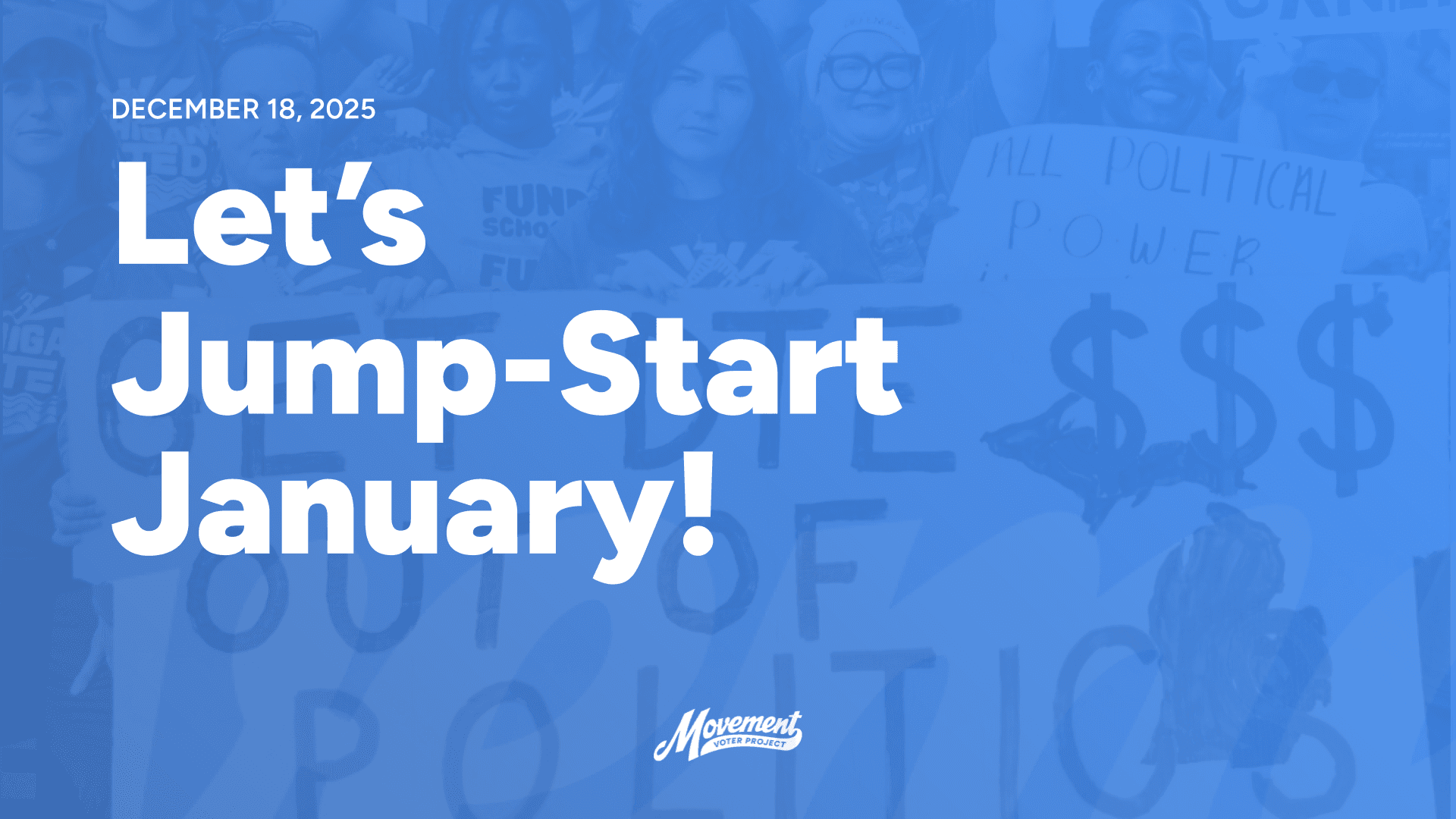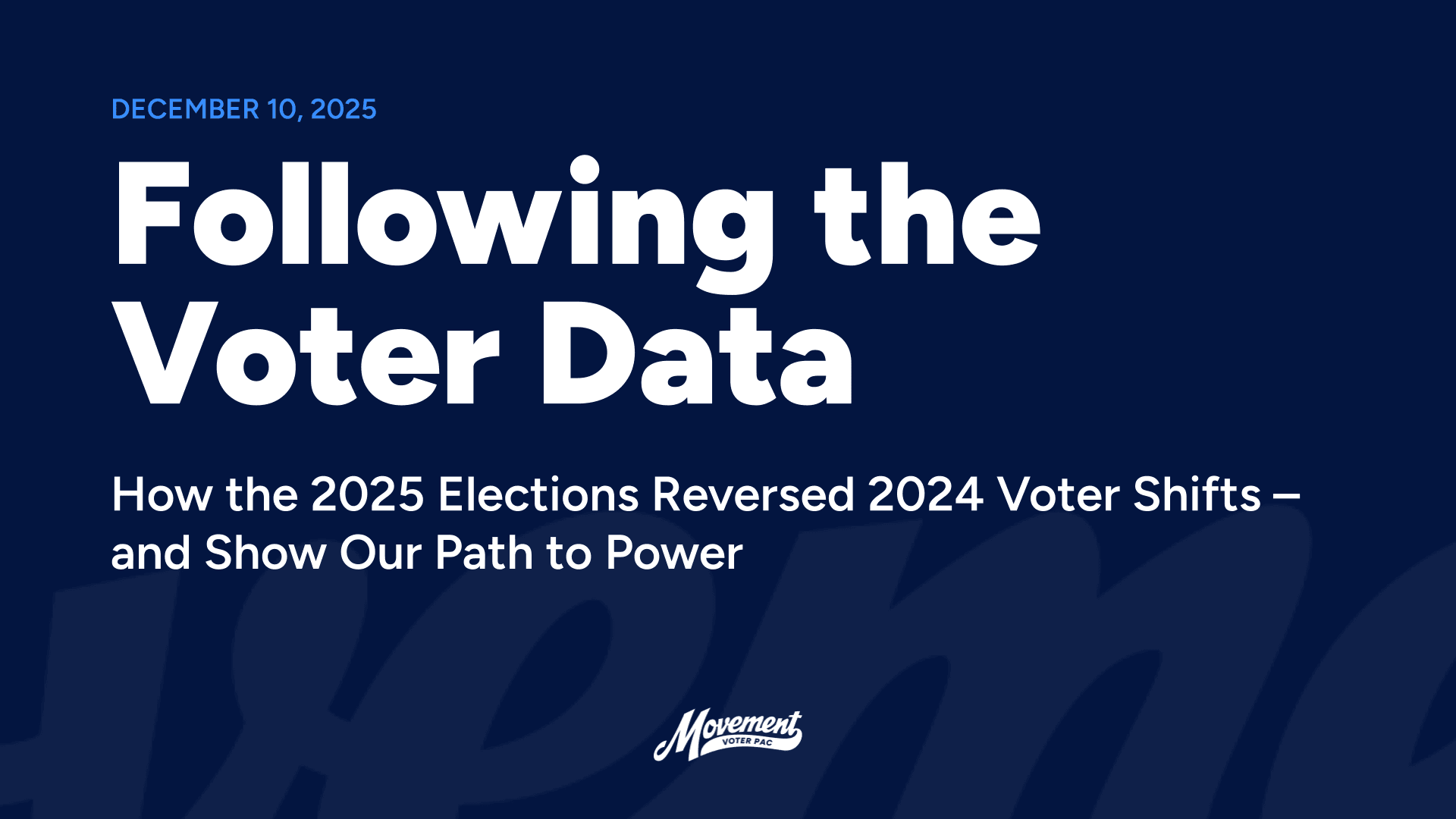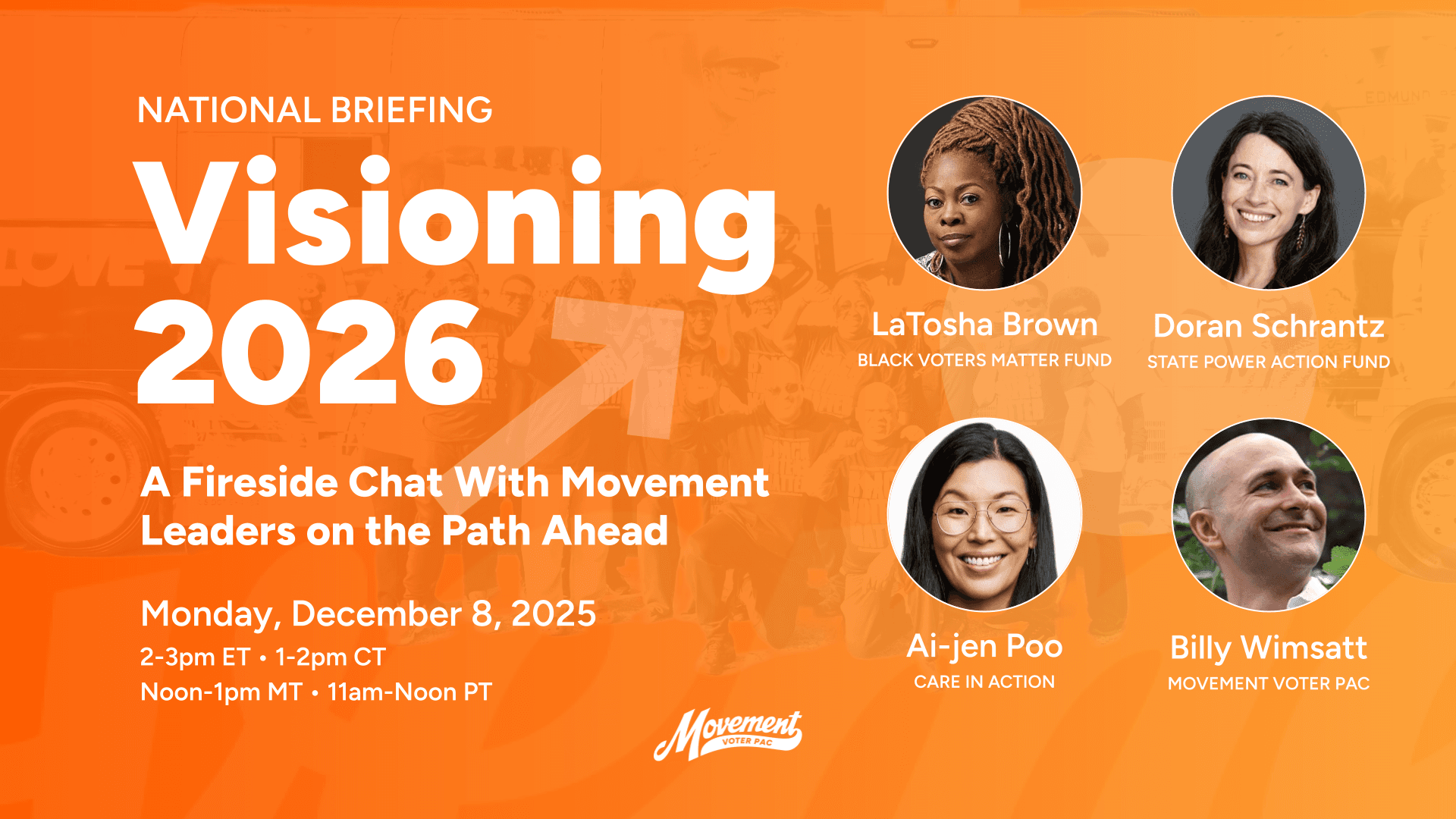Thanks in part to MVP’s strategic investments in local voter organizing earlier this year, the Maryland Senate race has gone from a nail-biting toss-up to a seat in which Democrats have a 99+% chance of winning.
To get the story, we sat down with Sarah Chaisson-Warner, MVP Senior State Strategy Director, who is also in charge of grantmaking and strategy in Maryland across the Northeast.
The following interview has been edited for clarity.
A Blue-State Republican Who Could Flip the U.S. Senate
How did this U.S. Senate race in Maryland become a toss-up that could determine control of the whole chamber?
When former Maryland Governor Larry Hogan entered the U.S. Senate race in February, he came in strong. He had a lot more name recognition than the Democratic primary candidates, and early polling gave him a 12-14 point lead. Republicans saw the opportunity in his candidacy, and his fundraising amassed.
The danger was, many Democrats weren’t pay a lot of attention – especially national funders. After all, Maryland is considered such a “blue state.”
What made you notice this race when relatively few others had it on the radar?
I took special interest in this race, because I had done work in Maryland as part of my work at [MVP partner] People’s Action to save the Affordable Care Act from repeal by then-President Trump and the GOP.
At that time, one of our major strategies was to engage “lonely Governors” - Republican Governors in traditionally blue states whom we could get to publicly speak out against GOP repeal efforts. Hogan was one of our targets. He’d been re-elected several times and had been distancing himself from Trump. The Northeast and Mid-Atlantic just love their “moderate” Republican governors! (Just look at New Hampshire, Vermont, and Massachusetts.) Hogan was fashioning himself in the same way.
Fast-forward to 2024, and I saw how he was positioning himself in the Senate race — coming out in support of abortion rights and even attending an LGBTQ pride event in June.
So Hogan was attempting to cast himself as a “reasonable moderate.”
Yes, exactly. He was attempting to sell himself in similar ways as before when he ran for Governor, but also embracing some traditionally Democratic social issues – even if it wasn’t entirely authentic.
The thing is, even as a “moderate” Republican governor, Hogan had blocked progress on all kinds of key issues, from health care to education and more. And now, the threat of his candidacy extended well beyond his own policy stances: He was a sleeper candidate who could single-handedly hand Republicans control of the Senate.
Our partners on the ground were clear-eyed about the race. It didn’t take them by suprise at all. They had been saying all along that Hogan was a real threat.
An Early Intervention to Shift the Race
So what did MVP do about all this?
I said to myself, “Oh, this is a big deal.” I realized: We can’t just wait and see if this race gets competitive or not. We need to make sure it doesn’t get competitive.
It was clear this race could easily become a competitive seat, without early and sustained interventions.
So we connected with two major players in the state — Progressive Maryland and CASA in Action — to support their early work not only to define Hogan with voters, but to create a statewide “table” of labor and community coalition partners to win the race.
In total, we invested $645,000 in partisan funds into these two organizations to help them ramp up their earned media campaign and direct voter contact work.
What has the “earned media” work looked like?
In April, as one example, our partners organized a well-covered press conference in the state capital to brand Hogan as a party-line GOP candidate who had blocked key progressive priorities in his time as governor. Here’s a clip from the Associated Press coverage:
“On Tuesday, a coalition of labor, immigration and progressive groups gathered in the state capital to criticize the former governor for using his veto powers to block legislation to increase abortion access while undermining other Democratic priorities, including health care, environmental protection and education funding.
The anti-Hogan event was a reminder that voters in his gubernatorial elections may have been more willing to overlook party affiliation than they will be in a Senate contest that could tilt the balance of power in Washington toward Republicans.”
What is the scope of the direct voter contact operation?
Our partners set out to knock on over 139,000 doors to elect Hogan’s Democratic opponent, Angela Alsobrooks. As of now, they are well on their way to that goal, with canvass programs are running in several counties, including Prince George’s County, Baltimore County, Howard and Arundel County, and Montgomery County.
Our partners have also supplemented their canvass program with phone banking, text banking, and relational organizing.
Can you say more about the “relational organizing” program at play here?
In an electoral program, relational organizing is about reaching voters through people they already know and trust. By harnessing the power of social ties and positive peer pressure, we can increase voter turnout and overcome the obstacles many voters face to casting their ballot.
Progressive Maryland has been piloting their relational organizing program in Baltimore in particular, which has a history of last-minute changes to polling locations and setup failures on Election Day. Just this year during the state primary, multiple polling places opened late or closed mid-day due to issues with supplies, equipment, and personnel.
Progressive Maryland believes that, by developing their relational program well in advance of the issues Baltimore will likely face again on Election Day, we’ll be able to proactively counteract them with solid systems for communicating with voters. People calling people they know, saying, “Hey, such-and-such polling location is closed, go here instead.” Or “heads up, really long lines at such-and-such polling place, plan in advance.” That has a very different effect than getting a mass text message from someone you don’t know.
To run their relational program, Progressive Maryland is using the cutting-edge Empower app (which MVP has also funded). Their program translates to roughly $6 dollars per voter, which is incredibly cost-effective. So, as part of our overall investment in this race, MVP made a grant through our Capacity Building Program to help triple their reach from 5,000 to 15,000 Baltimore voters.
A Stitch in Time Saves the Senate
So what is the state of the race now?
We’re keeping our eye on it, but this Senate race has now gone from “Lean R” to highly competitive to “Likely D.”
Would you say MVP’s interventions contributed to this shift?
Absolutely. Our entire theory in Maryland was that, by making early investments to help progressive groups define Hogan and remind voters of his record, we could keep the race from slipping away from Democrats and taking the entire chamber with it.
With MVP’s support, Progressive Maryland and CASA In Action have been able to successfully carry out their voter engagement efforts, particularly among BIPOC (Black, Indigenous, People of Color) communities and low-propensity voters, to define Hogan as a candidate who would not at all stand for progressive interests.
Later in the fall, after the primary, our partners have also been able to help raise Angela Alsobrook’s name ID, while continuing to engage persuadable voters.
None of this could happen without MVP’s early investment.
We can’t claim 100% direct causation here — or in any race for that matter — but this really is an example of how smart, locally-rooted earned media, combined with locally-rooted voter contact, can shift the narrative and shift our prospects dramatically.
So in other words, “a stitch in time saves the Senate.”
Exactly. That was the bet we were making with the funding we sent in the spring and summer: Invest early with a smaller amount, so we don’t have to come in the fall with millions to save a U.S. Senate race that never should have slipped away in the first place.
Building State Progressive Power for the Long Haul
How does it work when you’re funding multiple groups in a state like this? What is the dynamic?
Progressive Maryland and CASA In Action have been in consistent communication with each other throughout this whole campaign: Figuring out who is covering what voter contact turf, planning earned media efforts together. They’ve been great at sharing key intel and coordinating tactics.
And this really is one of the great things to come out of this effort. For states like Maryland that aren’t perennial battleground states, there isn’t a standing electoral coordination “table”. There isn’t a donor coordination table. So groups are self-organizing to build the kind of coordinating entities that are necessary not only to win now, but sustain themselves for the policy and electoral campaigns of the future.
This kind of work to nurture progressive “state ecosystems” is how we’ve made enormous progressive gains in Minnesota. It’s how a statewide coalition passed a constitutional amendment in Ohio in August 2023, which paved the way for passing an abortion rights measure that November, and which could now help re-elect Sherrod Brown to the U.S. Senate this November.
We’re seeing this play out now in New York and California too. In 2022, we lost the U.S. House by just a few thousand votes across a few races because we had not invested enough attention and resources in long-term state-level power building. Now, Battleground New York and Battleground California are up and running (thanks in part to MVP support), they are pounding the pavement to take back the House in 2024, and they are not going away in 2025. Our partners in Maryland are following this same track.
How We Win: Broad, Steady Investment in Local Organizing
What are the lessons from this story? How should it inform how we invest moving forward?
Good question. A few lessons:
- We’ve got to invest broadly. If all we do is fund the usual battleground states, we risk losing key federal races that can swing the entire balance of power. In fact, our final investment in Maryland not only allowed our partners to expand their Senate canvass, but to also canvass for the Democratic candidate for the U.S. House in CD-06, which is suddenly looking surprisingly tough. So if we win this race and also win the U.S. House by one seat this year, we might also have our Maryland partners to thank.
- We’ve got to invest long-term. If all we do is throw last-minute money at races that are slipping away from us, we will always be playing defense. It’s much more efficient to invest in year-round, bottom-up infrastructure that build power year after year.
- We’ve got to invest in long-term progressive “state ecosystems”. Part of why this Maryland Senate race is in good shape is that we funded two highly cooperative organizations who were able to pull together an even broader coalition of support — a coalition that will continue long after Election Day.
It seems like another key lesson here is the priceless value of locally-rooted relationships and knowledge.
Yes, absolutely. There’s a very strong case to be made around the power of sustaining relationships between funding intermediaries like MVP and our partners on the ground like Progressive Maryland and CASA In Action.
Our team had relationships with Maryland prior to this year, so it wasn’t difficult to make contact. I already knew the context in the state from my past work here. I literally already had the numbers in my phone. We didn’t have to start from scratch.
In terms of the locally-rooted knowledge, it really is invaluable.
There were moments in the last six months where I said, “Not many other funders seem to be concerned about this. I am. Am I in the wrong?” You naturally doubt yourself. But I worked in Maryland before. I knew this was going to be a problem. Our teammate, Eugenio Smith, who co-leads our Capacity Building Program, is a longtime organizer who had done work in Maryland as well. Eugenio was also an early cheerleader for early investment.
So there was an intuitive sense that this race was going to be important. But that intuition was informed by being steeped in the local context for years.
Year-Round, On the Ground!
And that’s the interview!
If you’re inspired by this story, take a moment to support MVP’s work to strengthen year-round local organizing in ALL the places and races that matter most.
Correction: October 11, 2024
An earlier version of this post misstated our partners' goal for door knocks to support Angela Alsobrooks, the Democratic candidate for Maryland's U.S. Senate seat. Their total goal is 139,000 doors, not 158,000.




